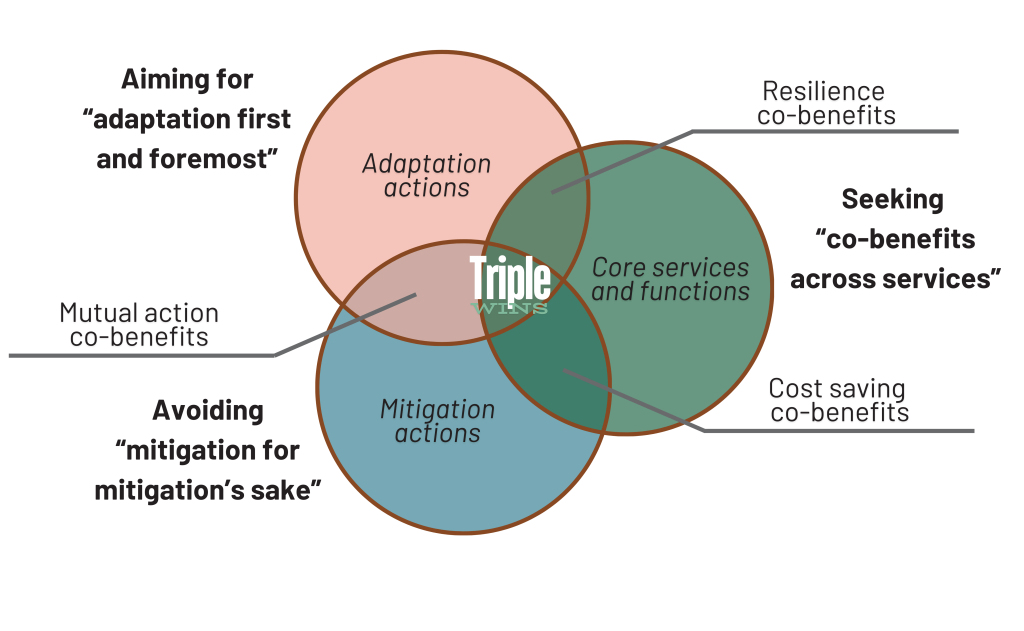Climate change is affecting how Huon Valley Council delivers its critical services and maintains infrastructure that the community depends upon by exacerbating the threats that existing extreme weather events pose. While Council is concerned about the impacts of climate change across all aspects of Huon Valley, from the local businesses to the protected areas, Council has limited direct control over most sectors, ecosystems, and individuals. As such, Council identifies adaptation actions within Council’s sphere of control and presents opportunities to advocate for actions within the sphere of influence. Responsibility, for Council, is informed by the limited available resources afforded to a rural/regional municipality. Yet, every investment in climate change is critical.

Council’s Adaptation Responsibilities
In Australia, “local governments are on the frontline in dealing with the impacts of climate change. They have an essential role to play in ensuring that local circumstances are adequately considered in the overall adaptation response, and that local communities are directly involved in adaptation efforts. Local governments are well positioned to inform State and Commonwealth governments about on-the-ground needs of local and regional communities, communicate directly with those communities, and respond to local challenges.”
Under the Roles and Responsibilities for Climate Change Adaptation in Australia (2012) local governments are responsible for:
- administering relevant state and territory and / or Commonwealth legislation to promote adaptation as required including the application of relevant codes, such as the Building Code of Australia
- managing risks and impacts to public assets owned and managed by local governments
- managing risks and impacts to local government service delivery
- collaborating across councils and with State and Territory Governments to manage risks of regional climate change impacts
- ensuring policies and regulations under their jurisdiction, including local planning and development regulations, incorporate climate change considerations and are consistent with State and Commonwealth Government adaptation approaches
- facilitating building resilience and adaptive capacity in the local community, including through providing information about relevant climate change risks
- working in partnership with the community, locally-based and relevant NGOs, business and other key stakeholders to manage the risks and impacts associated with climate change, and
- contributing appropriate resources to prepare, prevent, respond, and recover from detrimental climatic impacts.
To find out more about Council’s efforts to adapt to climate change, visit our Adaptation to Risks page.
Council’s Mitigation Responsibilities
Limiting the extent of warming can dramatically affect what the community needs to adapt to and the impact to people and the environment across the globe. While local governments can and should take actions to mitigate their emissions, Council acknowledges that the scale of both Council’s and the wider Huon Valley community’s emissions are marginal compared to industries and higher levels of government. Therefore, Council aims to only pursue mitigatory actions when they provide co-benefits (i.e. mitigate emissions and build adaptation) or provide significant cost savings (e.g. when funded through grants or meet cost-benefit thresholds).
Even though there are no national or state-level established roles and responsibilities to mitigate emissions, under the Local Government Act (1993) and Tasmania’s Climate Change Action Plan (2023), local governments in Tasmania play a crucial role in mitigating emissions through various responsibilities and actions, including:
- Developing and enforcing local policies and regulations that promote energy efficiency, renewable energy adoption, sustainable transport, and waste reduction.
- Implementing energy-saving measures in public buildings and infrastructure, promoting energy-efficient practices, and facilitating the transition to renewable energy sources.
- Promoting waste reduction, recycling, and composting programs to minimize methane emissions from landfills and improve overall waste management practices.
- Integrating sustainable urban design principles to reduce emissions from buildings and transport.
- Raising awareness about climate change and providing resources and support to the community to reduce their carbon footprint.
- Working with other levels of government, businesses, and community groups to advocate for broader climate policies and actions; and
- Keeping track of local emissions data, monitoring progress towards emissions reduction goals, and reporting on outcomes to ensure transparency and accountability.
To find out more about Council’s efforts to mitigate emissions, check out our Mitigating Our Emissions page.
Action Prioritisation
Our approach to prioritising climate change actions focuses on adaptation first and foremost because building resilience and preparing for climate impacts are crucial for safeguarding our community and operations. By emphasising adaptation, we ensure that our efforts directly enhance the organisation and community’s ability to cope with the inevitable changes brought by climate variability. Additionally, seeking co-benefits by integrating adaptation and mitigation actions with our core services and functions allows us to achieve multiple advantages simultaneously.
Adaptation efforts that enhance resilience also support our primary services, while targeted mitigation actions can lead to significant cost savings through improved energy efficiency and other measures. This integrated approach creates mutual action co-benefits, where adaptation and mitigation efforts align to provide synergistic advantages. By focusing on adaptation and co-benefits, we maximise operational efficiency, financial savings, and overall resilience, making our climate change strategy more effective and sustainable. This approach ensures that our climate actions are purposeful and beneficial across multiple dimensions, rather than pursuing mitigation for its own sake (Figure ?)


